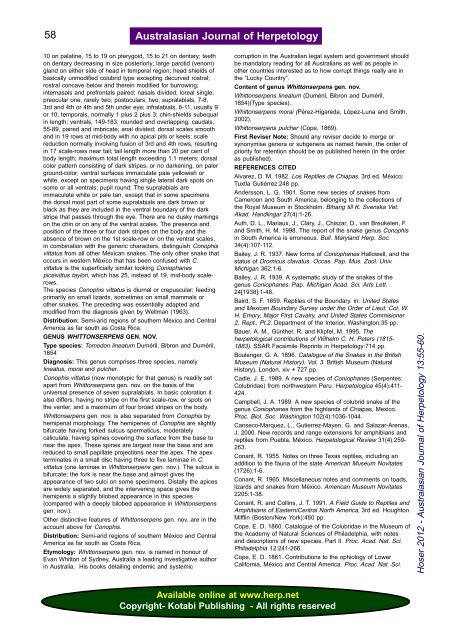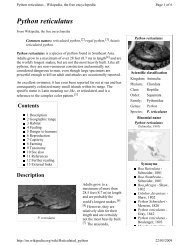Issue Thirteen 30 June 2012 - Taxonomic issue - all - Smuggled.com
Issue Thirteen 30 June 2012 - Taxonomic issue - all - Smuggled.com
Issue Thirteen 30 June 2012 - Taxonomic issue - all - Smuggled.com
You also want an ePaper? Increase the reach of your titles
YUMPU automatically turns print PDFs into web optimized ePapers that Google loves.
58<br />
10 on palatine, 15 to 19 on pterygoid, 15 to 21 on dentary; teeth<br />
on dentary decreasing in size posteriorly; large parotid (venom)<br />
gland on either side of head in temporal region; head shields of<br />
basic<strong>all</strong>y unmodified colubrid type excepting decurved rostral;<br />
rostral concave below and therein modified for burrowing;<br />
internasals and prefrontals paired; nasals divided; loreal single;<br />
preocular one, rarely two; postoculars, two; supralabials, 7-8,<br />
3rd and 4th or 4th and 5th under eye; infralabials, 8-11, usu<strong>all</strong>y 9<br />
or 10; temporals, norm<strong>all</strong>y 1 plus 2 plus 3; chin-shields subequal<br />
in length; ventrals, 149-183, rounded and overlapping; caudals,<br />
55-89, paired and imbricate; anal divided; dorsal scales smooth<br />
and in 19 rows at mid-body with no apical pits or keels; scale<br />
reduction norm<strong>all</strong>y involving fusion of 3rd and 4th rows, resulting<br />
in 17 scale-rows near tail; tail length more than 20 per cent of<br />
body length; maximum total length exceeding 1.1 meters; dorsal<br />
color pattern consisting of dark stripes, or no darkening, on paler<br />
ground-color; ventral surfaces immaculate pale yellowish or<br />
white, except on specimens having single lateral dark spots on<br />
some or <strong>all</strong> ventrals; pupil round; The supralabials are<br />
immaculate white or pale tan, except that in some specimens<br />
the dorsal most part of some supralabials are dark brown or<br />
black as they are included in the ventral boundary of the dark<br />
stripe that passes through the eye. There are no dusky markings<br />
on the chin or on any of the ventral scales. The presence and<br />
position of the three or four dark stripes on the body and the<br />
absence of brown on the 1st scale-row or on the ventral scales,<br />
in <strong>com</strong>bination with the generic characters, distinguish Conophis<br />
vittatus from <strong>all</strong> other Méxican snakes. The only other snake that<br />
occurs in western México that has been confused with C.<br />
vittatus is the superfici<strong>all</strong>y similar looking Coniophanes<br />
piceivittus taylori, which has 25, instead of 19, mid-body scalerows.<br />
The species Conophis vittatus is diurnal or crepuscular; feeding<br />
primarily on sm<strong>all</strong> lizards, sometimes on sm<strong>all</strong> mammals or<br />
other snakes. The preceding was essenti<strong>all</strong>y adapted and<br />
modified from the diagnosis given by Wellman (1963).<br />
Distribution: Semi-arid regions of southern México and Central<br />
America as far south as Costa Rica.<br />
GENUS WHITTONSERPENS GEN. NOV.<br />
Type species: Tomodon lineatum Duméril, Bibron and Duméril,<br />
1854<br />
Diagnosis: This genus <strong>com</strong>prises three species, namely<br />
lineatus, morai and pulcher.<br />
Conophis vittatus (now monotypic for that genus) is readily set<br />
apart from Whittonserpens gen. nov. on the basis of the<br />
universal presence of seven supralabials. In basic coloration it<br />
also differs, having no stripe on the first scale-row, or spots on<br />
the venter, and a maximum of four broad stripes on the body.<br />
Whittonserpens gen. nov. is also separated from Conophis by<br />
hemipenal morphology. The hemipenes of Conophis are slightly<br />
bifurcate having forked sulcus spermaticus, moderately<br />
caliculate, having spines covering the surface from the base to<br />
near the apex. These spines are largest near the base and are<br />
reduced to sm<strong>all</strong> papillate projections near the apex. The apex<br />
terminates in a sm<strong>all</strong> disc having three to five laminae in C.<br />
vittatus (one laminae in Whittonserpens gen. nov.). The sulcus is<br />
bifurcate; the fork is near the base and almost gives the<br />
appearance of two sulci on some specimens. Dist<strong>all</strong>y the apices<br />
are widely separated, and the intervening space gives the<br />
hemipenis a slightly bilobed appearance in this species<br />
(<strong>com</strong>pared with a deeply bilobed appearance in Whittonserpens<br />
gen. nov.).<br />
Other distinctive features of Whittonserpens gen. nov. are in the<br />
account above for Conophis.<br />
Distribution: Semi-arid regions of southern México and Central<br />
America as far south as Costa Rica.<br />
Etymology: Whittonserpens gen. nov. is named in honour of<br />
Evan Whitton of Sydney, Australia a leading investigative author<br />
in Australia. His books detailing endemic and systemic<br />
Australasian Journal of Herpetology<br />
corruption in the Australian legal system and government should<br />
be mandatory reading for <strong>all</strong> Australians as well as people in<br />
other countries interested as to how corrupt things re<strong>all</strong>y are in<br />
the “Lucky Country”.<br />
Content of genus Whittonserpens gen. nov.<br />
Whittonserpens lineatum (Duméril, Bibron and Duméril,<br />
1854)(Type species).<br />
Whittonserpens morai (Pérez-Higareda, López-Luna and Smith,<br />
2002).<br />
Whittonserpens pulcher (Cope, 1869).<br />
First Reviser Note: Should any reviser decide to merge or<br />
synonymise genera or subgenera as named herein, the order of<br />
priority for retention should be as published herein (in the order<br />
as published).<br />
REFERENCES CITED<br />
Alvarez, D. M. 1982. Los Reptiles de Chiapas. 3rd ed. México:<br />
Tuxtla Gutiérrez:248 pp.<br />
Andersson, L. G. 1901. Some new secies of snakes from<br />
Cameroon and South America, belonging to the collections of<br />
the Royal Museum in Stockholm. Bihang till K. Svenska Vet.<br />
Akad. Handlingar 27(4):1-26.<br />
Auth, D. L., Mariaux, J., Clary, J., Chiszar, D., van Breukelen, F.<br />
and Smith, H. M. 1998. The report of the snake genus Conophis<br />
in South America is erroneous. Bull. Maryland Herp. Soc.<br />
34(4):107-112.<br />
Bailey, J. R. 1937. New forms of Coniophanes H<strong>all</strong>owell, and the<br />
status of Dromicus clavatus. Occas. Pap. Mus. Zool. Univ.<br />
Michigan 362:1-6.<br />
Bailey, J. R. 1939. A systematic study of the snakes of the<br />
genus Coniophanes. Pap. Michigan Acad. Sci. Arts Lett.<br />
24[1938]:1-48.<br />
Baird, S. F. 1859. Reptiles of the Boundary. in: United States<br />
and Mexican Boundary Survey under the Order of Lieut. Col. W.<br />
H. Emory, Major First Cavalry, and United States Commisioner.<br />
2, Rept., Pt.2. Department of the Interior, Washington:35 pp.<br />
Bauer, A. M., Günther, R. and Klipfel, M. 1995. The<br />
herpetological contributions of Wilhelm C. H. Peters (1815-<br />
1883). SSAR Facsimile Reprints in Herpetology:714 pp.<br />
Boulenger, G. A. 1896. Catalogue of the Snakes in the British<br />
Museum (Natural History). Vol. 3. British Museum (Natural<br />
History), London, xiv + 727 pp.<br />
Cadle, J. E. 1989. A new species of Coniophanes (Serpentes:<br />
Colubridae) from northwestern Peru. Herpetologica 45(4):411-<br />
424.<br />
Campbell, J. A. 1989. A new species of colubrid snake of the<br />
genus Coniophanes from the highlands of Chiapas, Mexico.<br />
Proc. Biol. Soc. Washington 102(4):1036-1044.<br />
Canseco-Marquez, L., Gutierrez-Mayen, G. and Salazar-Arenas,<br />
J. 2000. New records and range extensions for amphibians and<br />
reptiles from Puebla, México. Herpetological Review 31(4):259-<br />
263.<br />
Conant, R. 1955. Notes on three Texas reptiles, including an<br />
addition to the fauna of the state American Museum Novitates<br />
(1726):1-6.<br />
Conant, R. 1965. Miscellaneous notes and <strong>com</strong>ments on toads,<br />
lizards and snakes from México. American Museum Novitates<br />
2205:1-38.<br />
Conant, R. and Collins, J. T. 1991. A Field Guide to Reptiles and<br />
Amphibians of Eastern/Central North America, 3rd ed. Houghton<br />
Mifflin (Boston/New York):450 pp.<br />
Cope, E. D. 1860. Catalogue of the Colubridae in the Museum of<br />
the Academy of Natural Sciences of Philadelphia, with notes<br />
and descriptions of new species. Part II. Proc. Acad. Nat. Sci.<br />
Philadelphia 12:241-266.<br />
Cope, E. D. 1861. Contributions to the ophiology of Lower<br />
California, México and Central America. Proc. Acad. Nat. Sci.<br />
Available online at www.herp.net<br />
Copyright- Kotabi Publishing - All rights reserved<br />
Hoser <strong>2012</strong> - Australasian Journal of Herpetology 13:55-60.



